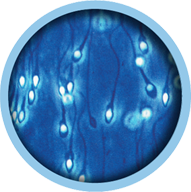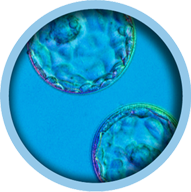
SPERMGRAD™
Efficient separation for increased progressive motility.
Purpose For gradient sperm separation.
Storage Store dark at +2 to +8°C
ASSORTMENT THAT MEETS YOUR NEED
The SpermGrad assortment contains both stock solutions and ready to use solutions, covering the needs from intermittent to high volume use - a time saver in an efficient laboratory. The stock solution is to be used after dilution with either G-IVF™ supplemented with G-MM™ or HSA-solution™, or with SpermRinse™.
Progressive motility correlates to pregnancy rates
The goal for sperm separation is to select the sperm cells with the highest capacity of fertilising an oocyte. High quality sperm show progressive motility, which in clinical studies has been shown to correlate to pregnancy rates.1,2,3
Normal spermatozoa, abnormal spermatozoa, other cells present in the semen sample and bacteria all have different densities. SpermGrad contains silica coated particles that allow for separation of spermatozoa and other cells according to their density.
REF: 1. Jouannet P et al. Internation Journal of Andrology, 11:379-394, 1998. 2. Larsen L et al. Human Reproduction, 15:1562-1567, 2000. 3. Zinman MJ et al. Journal of Andrology, 21:145-153, 2000
Clinical evaluation showed increased progressive motility
To investigate the quality of spermatozoa separated with SpermGrad, a clinical evaluation has been performed. The aim was to compare motility of the prepared samples and semen from 20 patients was included. The samples used for the comparison included severe male factor samples (<5 million/mL initial concentration with motility as low as 10%), as well as normal semen samples
The data showed that sperm separated using SpermGrad gave a higher proportion of progressively motile sperm in the sample, compared to a leading brand1. This means that SpermGrad facilitates a better separation where a larger proportion of dead and degenerating spermatozoa have been removed.
REF: 1. Meintjes M. Frisco Institute for Reproductive Medicine. Data on file, 2012.
Expand your knowledge about sperm
Broaden your knowledge about sperm and their contribution to the oocyte by watching the two lectures by a leading authority in the field, Prof. Christopher Barratt from University of Dundee. He describes some of the latest research about sperm and oocyte interaction.
Watch MoviesAdditional Documents
 |
SpermGrad™Short protocols |
This short protocol describes how to perform sperm preparation (density gradient method) using Vitrolife products.
 |
SpermGrad™Short protocols |
telomere length, sperm motility and DNA fragmentation
This short protocol describes how to perform sperm preparation (density gradient method) using Vitrolife products.
Yang Q, et al, found significant correlations between sperm telomere length and the quality of early embryonic development. Density gradient centrifugation using SpermGrad (Vitrolife) enrich for sperm with high mobility and low DNA fragmentation and is the preferred technique for selection of sperm with longer telomeres.






